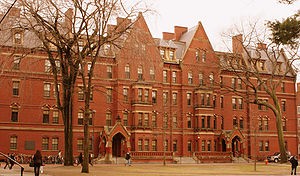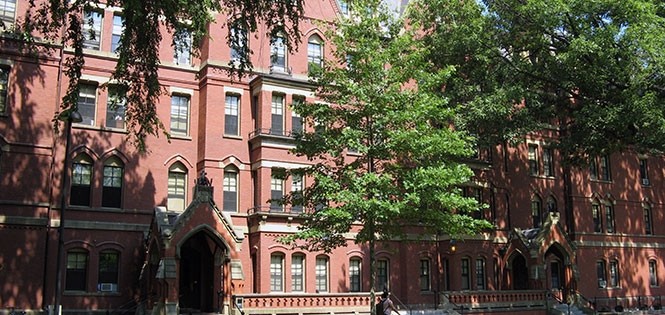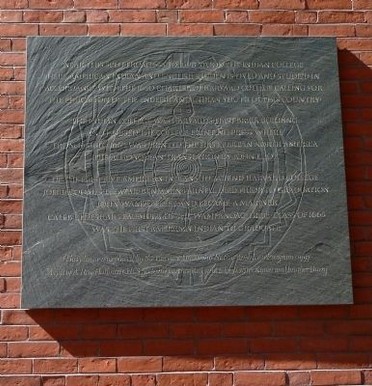Matthews Hall, Harvard University
Introduction
Author-Uploaded Audio
Listen to a narration of this entry's description by Victoria Endres.
Text-to-speech Audio
Images
Matthews Hall, Harvard University

Matthews Hall, Harvard University (image from Harvard University)

Indian College marker at Matthews Hall

Backstory and Context
Author-Uploaded Audio
Listen to a narration of this entry's description by Victoria Endres.
Text-to-speech Audio
Matthews Hall is a freshman dormitory for Harvard University, constructed in Harvard Yard in 1872. Named after Nathan Matthews of Boston, the hall is built on the site of the Indian College, Harvard's first brick building, which housed a printing press, classrooms, and living quarters for English and American Indian students from 1655 to 1698. The first Bible in North America was printed at the Indian College from 1659-1663, translated into Algonquian by John Eliot. Caleb Cheeshahteaumuck of the Wampanoag tribe was the first American Indian to graduate in 1665.
The Indian College and the Construction of Matthews Hall
Harvard University was on the verge of bankruptcy in 1646, ten years after the school's founding. The university asked for funds from the Society for the Propagation of the Gospel in New England; the Society agreed, provided that Harvard extend educational and spiritual resources to Native American students. Accordingly, in Harvard University's 1650 charter, the education of both English and American Indian youth was cited as the school's mission. Five years later, the Harvard Indian College was established in the university's first brick building. Both English and Native American students lived, dined, and attended lectures at the Indian College. Missionary John Eliot translated the Bible into Algonquian, and the first Bible published in the United States was printed on the press at Harvard Indian College beginning in 1659. Only five Native American students attended the Indian College, which stood from 1655 until 1698: Caleb Cheeshahteaumuck, Eleazar, Joel Iacoomes, Benjamin Larnell, and John Wampus. Wampus left school to become a mariner, and Eleazar, Larnell, and Iacoomes died before graduating. Iacoomes, of the Wampanog Tribe of Martha's Vineyard, had completed four years at Harvard, and died in a shipwreck before commencement. He was awarded a diploma posthumously in 2011. Caleb Cheeshahteaumuck, also of the Wampanoag tribe, graduated in 1655.
The Indian College was torn down in 1698; though Harvard promised rent-free housing to Native American students, it was 300 years before another American Indian graduated from the university. Near the same spot in Harvard Yard, work began in the spring of 1870 on a new college hall, funded by Bostonian Nathan Matthews. The five-story Gothic building cost $120,000 to erect, and required the relocation of Dane Hall seventy feet south and modifications to Wadsworth House in order to accommodate its size. In exchange for his donation, Matthews required that half of the income from the rooms of the new dormitory be used as scholarship funds for aspiring Protestant Episcopal ministers. Matthews Hall has been home to Philip Warren Anderson, William Randolph Hearst, Mark Penn, Matt Birk, John Dos Passos, Barney Frank, Maura Healey, Daniel Quillen, Maurice Wertheim, Robert Rubin, Lloyd Shapley, Chuck Schumer, and Matt Damon.
Reconnecting to Harvard's American Indian History
In 1970, the American Indian Program (now known as Harvard University Native American Program or HUNAP) was established at Harvard University. One of the program's accomplishments occurred in 1997, when the historical marker commemorating the Indian College was placed on Matthews Hall. Conceived by Standing Rock Sioux Susan Power and donated by Oneida Ray Halbritter, the plaque was dedicated in a ceremony with over 300 attendees.
In 2005, a HUNAP initiative led to an ongoing archaeological excavation of Harvard Yard, Digging Veritas, through Harvard's Peabody Museum. Archival research, combined with findings from the field, are being used to "explore the relationship between Harvard and the Native American community" [5]. Among the artifacts recovered are type pieces from the Indian College's printing press. The foundation of the original building was found in 2009. One student who participated in the project, Tiffany Smalley, became the first Wampanoag member to graduate since Caleb Cheeshahteaumuck. At her graduation in 2011, Smalley received Joel Iacoome's posthumous degree, 346 years after his death and 375 years after the founding of Harvard.
Historic marker inscription:
Indian College
Near this spot from 1655 to 1698 stood the Indian College. Here American Indian and English students lived and studied in accordance with the 1650 charter of Harvard College calling for the education of the English and Indian youth of this country.
The Indian College was Harvard’s first brick building and housed the college printing press where from 1659 to 1663 was printed the first Bible in North America, the Algonquian translation by John Eliot.
Of the first five American Indians to attend Harvard College, Joel Iacoomes, Eleazar, Benjamin Larnell died prior to graduation, John Wampus left and became a mariner, Caleb Cheeshahteaumuck of the Wampanoag tribe, class of 1665, was the first American Indian to graduate.
This plaque was placed by the Harvard University Native American Program, 1997. A gift of A. Ray Halbritter, HLS ’90, to his parents Ray and Gloria, sister Karen and brother Barry.
Sources
Baena, Victoria A.. The Harvard Indian College, The Harvard Crimson. March 24th 2011. Accessed November 1st 2020. https://www.thecrimson.com/article/2011/3/24/harvard-indian-american-native/.
A degree delivered, Harvard Gazette. May 26th 2011. Accessed November 1st 2020. https://news.harvard.edu/gazette/story/2011/05/a-degree-delivered/.
"History of Harvard Yard Buildings." Cambridge Tribune April 22nd 1905. .3.
Sinnott, Roger W.. Indian College, Historical Marker Database. October 8th 2014. Accessed November 1st 2020. https://www.hmdb.org/m.asp?m=77789.
Vaille, Frederick Ozni. Clark, Henry Alden. The Harvard Book: A Series of Historical, Biographical, and Descriptive Sketches. Volume 1. Welch, Bigelow, 1875.
Image from The Full Wiki
Image from Harvard University
Image from Historic Markers Database
